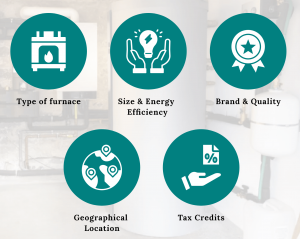 Last updated: June 18th, 2024
Last updated: June 18th, 2024
Furnace Upgrade Essentials: Navigating Costs, Estimates, and More

Is your furnace struggling to keep up with the demands of winter? Are you facing skyrocketing heating bills? According to recent data, the average US household spends between $349 and $650 on furnace repairs, and more if it’s a high-end repair. If you’re one of them, it’s time for a furnace upgrade!
However, upgrading your furnace can also be a significant investment. This article will provide you with the essential information you need to navigate the process of upgrading your furnace
Signs Furnace Needs A Replacement
Before we get to the furnace replacement costs, let’s first understand when you should opt for a new furnace.

The following are some significant signs that your furnace may require replacement.
- Age of Your System
Age is one of the first indicators that your furnace needs a replacement. The average lifespan that furnaces typically have is 15 to 20 years. If yours is nearing or has exceeded this range, it may be time for a replacement. As furnaces age, they become less efficient and more prone to breakdowns. - Rise in Energy Bills
Have you noticed a sudden increase in your energy bills without any major changes in your household? If so, it could indicate that your furnace is no longer operating efficiently. As furnaces age, they lose their ability to heat your home effectively, causing them to work harder and consume more energy. If your energy bills have been consistently higher than usual, it indicates that your furnace needs to be replaced. - Excessive Dust or Dirt
Another sign that your furnace needs a replacement is the presence of excessive dust, dirt, soot, or rust particles. As furnaces age, their internal components can deteriorate, releasing these particles into the air. Not only can this affect the air quality you breathe, but it can also be a warning sign that your furnace is no longer functioning correctly. - Humidity Problems In Home
If you’ve been experiencing issues with humidity levels in your home, it could be due to a faulty furnace. A properly functioning furnace helps regulate humidity levels by removing excess moisture from the air. However, as furnaces age, they may struggle to maintain the ideal humidity levels, leading to problems such as dry skin, static electricity, and mold growth. - Unusual Noises
Have you noticed that your furnace has become unusually noisy? Strange rattles buzzes, or hums could indicate mechanical problems within the system. Over time, wear and tear can cause components to become loose or damaged, resulting in these noises. While minor issues can be repaired, persistent and disruptive noises often indicate that a replacement is necessary. - Rust or Cracks On the Furnace
Inspecting your furnace for visible signs of rust or cracks is another way to determine if it needs to be replaced. Rust or cracks in or around the system can occur due to age, corrosion, or water damage. These issues can compromise the efficiency and safety of your furnace. - Frequent Repairs
If you find yourself calling for furnace repairs more often than not, it may be a sign that your furnace is reaching the end of its life cycle. While occasional repairs are expected, frequent visits from a technician can be costly and inconvenient.Ignoring these warning signs may decrease efficiency and increase energy costs and safety risks. Watch out for these signs; if you notice any, it’s time for the replacement.
Factors Affecting Replacement Costs
Once you finalize the replacement project, it’s time to understand the key elements that can impact costs.

In this section, we will explore the factors affecting furnace replacement costs and provide expert insights to guide your decision-making process.
1. Type of furnace
Here, we’ll look closely at common furnace types and provide an overview of the expected replacement costs.
|
Type Of Furnace |
Description |
Replacement Cost |
|
Electric |
This furnace uses electricity as its primary energy source. It is known for its ease of installation and relatively low upfront costs. However, electric furnaces have higher operational costs than other types. |
Basic Furnace: $1,500 – $5,000 Advanced Furnace: $5,000 – $10,000 |
|
Natural Gas |
Natural gas furnaces are one of the most popular choices among homeowners. They are cost-effective, efficient, and provide consistent heat. However, the initial cost of installing a gas furnace is usually higher than an electric furnace. |
Basic Furnace: $2,500 – $7,500 Advanced Furnace: $7,500 – $15,000 |
|
Oil Furnace |
Oil furnaces are commonly found in colder regions where access to natural gas may be limited. Although they provide excellent heating performance, oil furnaces require a storage tank and regular fuel deliveries, which can add to the overall maintenance and operational costs. |
Basic Furnace: $3,000 – $8,000 Advanced Furnace: $8,000 – $15,000+ |
|
Propane |
Propane furnaces are similar to oil furnaces in terms of requirements and performance. They are widely used in areas where natural gas lines are not available. However, homeowners should consider the cost of propane and its availability in their area before opting for this type of furnace. |
Basic Furnace: $3,000 – $8,000 Advanced Furnace: $8,000 – $15,000+ |
|
Green Furnace |
Green furnaces, or high-efficiency, are designed to minimize environmental impact and maximize energy efficiency. While they may have a higher initial cost, they can significantly reduce long-term energy consumption and lower utility bills. |
$10,000 – $25,000+ |
Note: These are the estimates of furnace replacement and can vary based on various factors, such as your location, the complexity of the installation, and the specific features or upgrades you choose. It’s always best to obtain quotes for an accurate estimate for your specific furnace replacement project.
2. Size & Energy Efficiency
The size of the furnace and its energy efficiency rating are crucial factors that affect the replacement costs. A correctly sized furnace ensures optimal heating performance and energy efficiency.
Oversized units can lead to frequent cycling, inefficient operation, and increased energy consumption. Undersized units, on the other hand, may struggle to provide sufficient heat, leading to discomfort and higher utility bills.
Moreover, the energy efficiency of a furnace is measured by its Annual Fuel Utilization Efficiency (AFUE) rating. The higher AFUE rating indicates that the furnace is more efficient. While high-efficiency furnaces may have a higher upfront cost, they can result in long-term savings by reducing energy consumption and utility bills.
3. Brand & Quality
Established and reputable brands often command higher prices due to their reliability, performance, and warranty coverage. While it may be tempting to opt for a budget-friendly brand, it is essential to consider the long-term value and potential maintenance and repair expenses associated with lower-quality furnaces.
4. Geographical Location
Factors such as climate, availability of fuel sources, and local regulations can affect the installation, maintenance, and operational costs. For example, colder regions may require larger furnaces to accommodate increased heating demands, leading to higher upfront costs. In contrast, areas with access to a natural gas supply may benefit from lower operational costs.
5. Tax Credits
When replacing a furnace, exploring any available tax credits and incentives offered by government agencies or utility companies is essential. These incentives can significantly reduce the replacement costs and make energy-efficient furnaces more affordable.
The government provides two types of home energy tax credits: the Energy Efficient Home Improvement Credit and the Residential Energy Clean Property Credit, out of which you can claim one, depending on your qualification. Moreover, check with the local authorities and utility providers to determine if any programs or rebates are available in your area.
Additional Cost Considerations
Along with the major elements, you must consider some extra things. We have listed them below. Take a look:
- Permits
The permits ensure that the replacement is done safely and complies with local building codes. The cost of permits can vary depending on your location, with some areas charging a flat fee and others calculating fees based on the value of the project. - Removing Old Furnace
The complexity of this task can impact the overall cost. Factors such as the size and type of the existing furnace, accessibility, and any additional requirements for safe removal will influence the labor and disposal fees. - Relocation Of Furnace
If you decide to relocate your furnace during the replacement process, it can add to the overall cost. Moving the furnace may require modifications to the existing ductwork, gas lines, or electrical connections. The complexity of the relocation, along with the materials and labor involved, will determine the additional expenses.
DIY Installation vs. Professional Installation
DIYing tasks have become increasingly popular among homeowners, thanks to abundant online tutorials and resources. It can be a cost-effective option, eliminating the need for professional labor expenses.
While DIY installation may seem appealing, it is essential to consider your investing time. If you don’t have any prior experience with DIYing installations, you would probably need to purchase certain tools.
On the other hand, entrusting the task to a qualified technician ensures the job is done correctly and efficiently. Skilled technicians have the expertise to identify and address potential problems before they become major headaches. Furthermore, professional installations often come with warranties, giving you peace of mind if any issues arise.
How to Save Money on New Furnace Installation
Worried about the hefty price tag? We understand that investing in a new furnace can be a significant expense, but with the right strategies, you can save money on your new furnace installation. Let’s see how!
- Get Multiple Quotes
It’s always a good idea to shop around and get multiple quotes from different contractors before deciding. Each contractor may have varying prices, warranties, and installation timelines, so by comparing quotes, you can ensure you are getting the best deal.
Be sure to ask for detailed breakdowns of the costs, including equipment, labor, permits, and any additional fees. Don’t forget to consider the contractor’s reputation, experience, and customer reviews when deciding.
- Go Off Season
Timing is the key to installing a new furnace. Planning your installation during the spring or summer months can potentially save you money. The demand for furnace services is typically lower during these seasons.
Contractors may offer discounted rates or promotions to attract more customers in the summers. By taking advantage of these off-peak seasons, you can score a better deal on your new furnace installation.
- Try A Home Warranty
Consider purchasing a home warranty that includes coverage for your furnace replacement. A home warranty is a service contract that helps protect major systems and appliances in your home from unexpected repairs or replacements. By having a home warranty, you can avoid paying out of pocket for costly repairs or replacements. Many home warranty companies on the market include furnace coverage under basic plans. You can explore such plans to save on repair and replacement costs.
Conclusion
In conclusion, recognizing the signs that your furnace needs a replacement is crucial for maintaining a comfortable and energy-efficient home. Similarly, upgrading to a reliable furnace ensures optimal heating performance, lower utility bills, and peace of mind. So, don't let unexpected costs catch you off guard — take proactive steps and stay warm.
related articles
 Discover First American Home Warranty Locations and What You Need to Know About Their Cover.
Discover First American Home Warranty Locations and What You Need to Know About Their Cover.
 Reviews of Home Warranty Companies Show You How to Determine If Your Home Is Covered
Reviews of Home Warranty Companies Show You How to Determine If Your Home Is Covered











